History of the Rialto Bridge on Venice Grand Canal
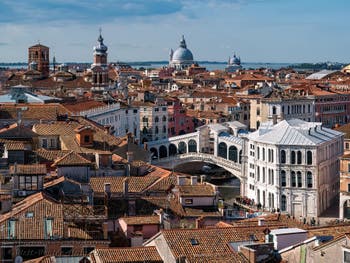
The Rialto Bridge The Rialto Bridge is undoubtedly one of the most potent symbols of Venice, along with the Doge's Palace and St Mark's Basilica.
The circumflex accent shape of the Rialto Bridge has toured the world, being in almost all tourist advertisements offering stays in Venice.
And yet, before getting there, the history of the Rialto Bridge was very long and complicated.
The Rialto Bridge, the only bridge over the Grand Canal
For a very long time, before the construction of the Scalzi Bridge at the Venice station or that of the Accademia Bridge, and finally, in 2008, the Constitution Bridge, nicknamed Calatrava, the Rialto Bridge was the only bridge spanning the Grand Canal, which made it a vital work as a link between the two central banks of the city of Venice but also on a purely commercial level.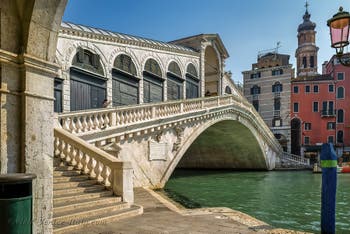
The Rialto Bridge Initially, the Rialto Bridge's area was the centre of Venetian commerce, on the side of the Sestier of San Polo.
Here was located the largest vegetable and fish market in Venice, and still is; here worked the first bankers of Venice.
Right next to the Rialto Bridge stands the Palazzo dei Camerlenghi, the palace of the treasurers of the Venetian State.
As a commercial and financial centre, the Rialto area needed more than boats and gondolas to connect with the rest of the city.
A bridge was necessary for the economic development of Venice.
Rialto Bridge was first a Bridge of Moored Boats
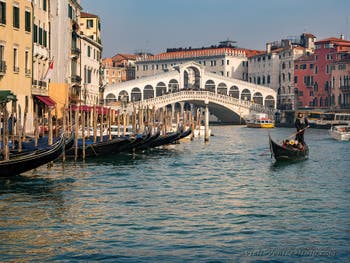
The Rialto Bridge The origin of the bridge dates to around 1172. At that time, a bridge of moored boats joined the two banks.
The architect was Nicolo Barattieri, who in the same year erected the two columns of the Piazzetta of Saint Mark with at their top the statues of Saint Theodore for one and of the Lion of Saint Mark for the other.
This makeshift solution could only be temporary, so it was decided to build a solid bridge.
Like most bridges in Venice at the time, the first Rialto Bridge was built of wood.
The building of a wooden bridge was faster, cheaper and, above all, represented the lightest solution compared to stone.
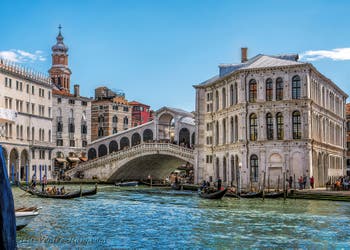
The Rialto Bridge This essential element conditioned all the architecture of Venice as you can still admire it.
Each architectural work in Venice, from the most miniature house to the most famous palace, responds to the same basic construction principle: start by driving wooden piles into the mud of the lagoon to form the foundations of the building.
The larger the construction, the heavier it is, and the more piles are needed to support it, which will be technically more complicated and fragile.
Finally, more piles also mean more money for building!
1264 - The First Rialto Bridge was Made of Wood
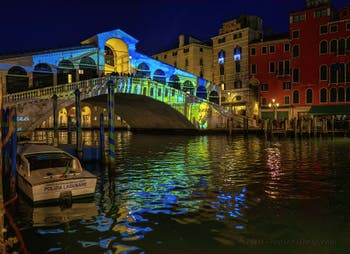
The Rialto Bridge According to the representations of the time, the first Rialto Bridge in Venice had a drawbridge in its centre, so most significant boats using the Grand Canal could pass through, including the ceremonial vessel of the Doges of Venice, the famous Bucintoro.
All great solemn processions of the Doges passed through the Grand Canal; this element represented an additional constraint for constructing the Rialto Bridge, which should not hinder the passage of the Bucintoro.
Therefore, the single arch of the Rialto Wooden Bridge was 7.50 metres in height.
As you can imagine, a wooden bridge, bathed in seawater and supporting an ongoing pedestrian passage at the time, the only bridge connecting the two banks of the Grand Canal of Venice, would have a limited lifespan.
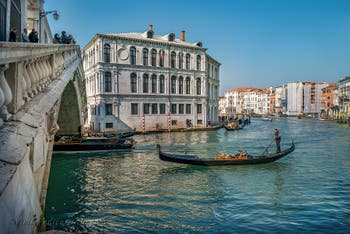
The Rialto Bridge Shops were also on the Rialto Wooden Bridge; like many town bridges in the Middle Ages, it had a commercial function because it was located in one of the most commercial places in Venice.
As the bridge's damage worsened, it closed at the end of the 13th century, so merchants and their shops had to leave. Occasionally, they got the right to return.
Nowadays, you will see many hotels and restaurants in this part of Venice. Still, the Rialto mostly means old Venice's market, the fish market, and the vegetable market named the Erberia.
1400 to 1499 - Repeated Reconstructions of the Rialto Bridge in Venice
The Rialto Bridge got first a renovation rather than a fundamental reconstruction.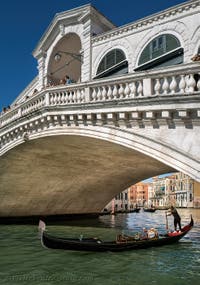
The Rialto Bridge Moreover, this restoration quickly proved insufficient; in 1432, the Grand Council of Venice decided to reconstruct the Rialto Bridge for a substantial sum at that time, 2323 ducats.
In 1444, unfortunately, part of the Rialto Bridge collapsed under the weight of the Venetians assembled on the bridge to see the Marchioness of Ferrara's wedding procession passing in the gondola.
That bridge also had a festive function, being a privileged place for Venetians to attend the great festivals of Venice, like the passage of the Doge in the Bucintoro and other processions.
In 1458, one started again.
The wooden bridge deteriorated again and was rebuilt, integrating two rows of shops along its parapets.
According to the chronicles of the time, more than twenty shops were present on the Rialto Bridge, manufacturing stringed instruments, perfumeries, bookshops, etc.
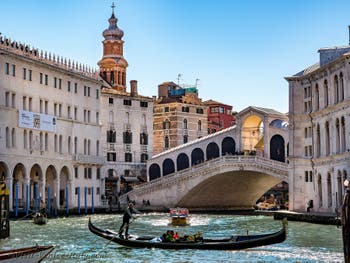
The Rialto Bridge Nowadays, there are still shops on this famous bridge in Venice!
New damage was noted between July and September 1472, and Venice decided to replace part of the stilts constituting the bridge's foundations.
But the restoration of 1472 quickly showed its limits, and in 1499 the bridge could collapse again due to its pillars rotting.
This single bridge spanning the Venice Grand Canal got permanent constraints from the constant crowd crossing it and the continuous passage of boats that damaged its pillars.
As early as 1507, the leaders of Venice had thought that the Rialto Bridge would have to be rebuilt in stone to withstand these damages.
On August 25, 1524, the entire ramp of the bridge located on the Rialto side collapsed!
But despite this, the decision to rebuild a stone Rialto bridge was again postponed, and the wooden bridge was again repaired.
Building of a Stone Rialto bridge
Back to Top of Page

